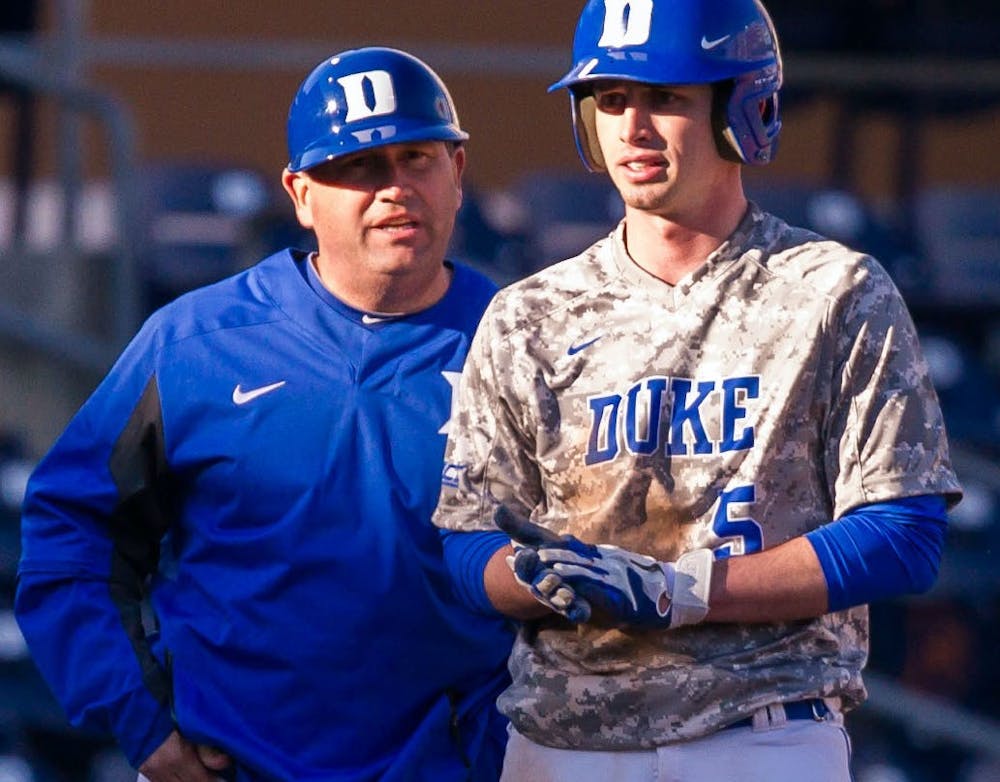There’s a data revolution happening in college baseball, and Duke’s among those leading the charge.
The last few years have brought an explosion of available data to the sport thanks to TrackMan technology, which uses video and radar to track valuable information for both hitters and pitchers. With TrackMan data, a dedicated coaching staff, some innovative students and a willing roster, the Blue Devils are now a well-oiled analytics machine.
I spoke with numerous sources involved in Duke baseball’s analytics transformation to get a picture of how data plays a role in the program today and how it has coincided with the team’s rise to national prominence. Long story short, the effects of the data influx cannot be overstated.
“I think that we've leveraged our resources as good as the top 5% in the country have leveraged theirs,” pitching coach Chris Gordon told The Chronicle. “I know there's not 30 schools out there doing it better than us. I think we're in that top echelon. Trackman’s pretty prevalent now...but with our systems to interpret the data, get visualizations out to players, I think that's where we're doing as good a job as anybody in the country.”
When many people think of advanced statistics in baseball, they think of Moneyball and suits in the front office finding market inefficiencies based on box scores. Well, TrackMan and other ball-tracking data has completely changed the game.
By tracking the speed and path of the ball every pitch, a whole new treasure trove of metrics become available, including spin rate, exit velocity, launch angles, release points and spray charts. These measures can be more useful for player development than data from box scores, as they pinpoint clear numbers that players can improve upon rather than evaluating their performances based on external factors. For example, a pitcher can tweak his mechanics to improve his spin rate on breaking balls or a batter can look at his launch angle to try to optimize his power at the plate.
These new data points have become Duke’s focus, and actually implementing these tools in player evaluation and improvement can largely be traced to Gordon, who was promoted to pitching coach this month after spending three seasons as an assistant to the head coach.
Gordon came to Durham in 2017, right when TrackMan was introduced to the program. From that point on, how to interpret and use TrackMan data fell a lot on Gordon’s shoulders. You see, TrackMan spits out data in a highly convoluted Excel file that can have as many as 5,000 rows. Making sense of this is no easy task, and Gordon turned to some undergraduate and graduate students to form an “analytics team.”
Among the members of the analytics team are former Fuqua School of Business student Max Rank and current Duke senior Daniel Landa, who helped Gordon and the coaching staff to compile the TrackMan data into a more palatable and informative format.
“The new data revolution in college baseball is pretty young, so all these teams are trying to feel it out, figure out how they can make the most efficient system that minimizes the technical work of the coaches,” Landa told The Chronicle. “And I quickly saw that they embrace the data, they love it, but they don't have an automated process to actually sift through the data and create reports…. And so we kind of saw a gap in the market, where you could throw in actual software that does it for you, and allows the coaching staff to spend as much time as as they can with the players and actually developing their skills based on the data, rather than playing with the data and making use of the files that TrackMan provides.”
Around the time they started working for the Blue Devils early last season, Rank and Landa co-founded Top Rank Analytics, a baseball analytics firm. With the new start-up, the two now work as consultants for the team. So, before Duke takes on a certain opponent, the coaching staff may request scouting reports on opposing pitchers. Then, Top Rank Analytics would provide a scouting report of every member of the opposing pitching staff, including information such as fastball tendencies over certain counts and release points on different types of pitches.
Hitting coach Jason Stein would then be tasked with distributing these reports to his players, and translating the data into a way that can lead to on-field results.
“As close as five years ago, [coaching] was just a lot of feel—you coached a lot with your eyes,” Stein told The Chronicle. “So now you're either stuck in the past, and guessing, or you can make really good decisions for your players, based on this data.”
Aside from likely aiding the team's on-field performance, Duke’s embrace of analytics has another upside: it’s a massive tool for recruiting. By gaining a reputation as a trailblazer on the frontlines of the data revolution, head coach Chris Pollard and his staff have gained a valuable new selling point for prospective Blue Devils.
“It shows our top recruits that we're going to provide the very best resources for them—if they make the decision to come to Duke, they're going to have access to that data,” Pollard told The Chronicle. “We're not only going to implement that data, but we're going to teach them to understand and use that data in their development program. We are big on our players really embracing and owning their own development and part of that is teaching them how to use the data to their advantage.”
It’s clear that analytics are here to stay in college baseball. And as they continue to evolve, Duke baseball seems primed to continue welcoming it with open arms.
Jake Piazza contributed reporting.
Get The Chronicle straight to your inbox
Signup for our weekly newsletter. Cancel at any time.

